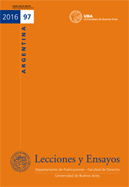La responsabilidad de proteger
Keywords:
international community, sovereignty, security counsel, responsibility to protect, human rightsAbstract
The concept of Responsibility to Protect has dominated the debate of humanitarian intervention since it was itself created in 2001 with the report of the International Commission on Intervention and State Sovereignty (ICISS). This is an idea that, even though shared by the International Community in general in the sense that it is necessary to ensure the right of life and integrity of people as the ultimate purpose of the universal system of protection of human rights, it has a considerable amount of criticism. It may generate a feeling of distrust, mainly in the weak and unstable countries due to the fact that R2P can transform in a “Troyan Horse” to be used by the powerful countries to inter- vene the former as they please and by doing so, obtain benefits non sanctos.
This is why it is extremely important to set up a system with clear rules that, on the one side, assure the protection of fundamental human rights of every single human being without paying attention to nationalities and, on the other, set a clear limit for the execution of interventions so as to prevent abuses from the powerful.
Downloads
References
BENVENISTI, Eyal, “Sovereigns as Trustees of Humanity: On the Accountability of States to Foreign Stakeholders”, en The American Journal of International Law, Vol. 107, No. 2, 2013.
BIEDMA, José, “El Contractualismo de Locke”, en Filosofía y Ciudadanía. Lecciones de Introducción de Filosofía. Instituto Francisco de los Cobos, consultado en [http://filosofayciudadana.blogspot.com.ar/2012/04/el-contractualismo-de-locke.html] 2012.
BLÄTTER, Ariela & WILLIAMS, Paul, “The Responsibility Not to Veto”, en Global Responsibility to Protect, Vol. 3, Issue 3, 2011, pp. 301-322.
BORSHCHEVSKAYA, Anna, “Russia’s Many Interests in Syria”, en The Washington Institute. Improving the Quality of U.S. Middle East Policy, consultado en [http://www.washingtoninstitute.org/policy-analysis/view/russias-many-interests-in-syria] 2013.
CASTIGATES, Pillay, “Paralysis” on Syria, UN High Commissioner for Human Rights, 2014.
CONSIGLI, Alejandro, La Intervención Humanitaria a la Luz del Derecho Internacional Actual, consultado en [http://www.corteidh.or.cr/tablas/R21642.pdf] 2004.
ELDEN, Stuart, “Contingent Sovereignty, Territorial Integrity and the Sanctiti of Borders”, en SAIS Review of Internacional Affairs, vol. XXVI, n°1, 2006.
FERNÁNDEZ SANTILLÁN, José, El Despertar de la sociedad civil, México, Océano Express, 2012.
FIXDAL, Mona & SMITH, Dan, “Humanitarian Intervention and Just War”, en The International Studies Association, vol.42, n°2, 1998, pp. 283-312.
GARRIGUES, Juan, “La Responsabilidad de Proteger: De un principio ético a una política eficaz”, en Fundación para las Relaciones Internacionales y el Diálogo Exterior (FRIDE), consultado en [http://fride.org/publicacion/298/la-responsabilidad-de-proteger:-de-un-principio-etico-a-una-politica-eficaz] el 23/11/2007.
GROVE, Thomas, Insight: Syria Pays for Russian Weapons to Boost Ties with Moscow, REUTERS, consultado en [http://www.reuters.com/article/us-syria-crisis-russia-arms-insight-idUSBRE97S0WW20130829] el 29/08/2013.
HOMERO, La Odisea, Madrid, Ediciones Cátedra, 2006.
HURD, Ian, After Anarchy: Legitimacy & Power in the United Nations Security Council, New Jersey, Princeton University Press, 2007.
NAUMANN, Klaus, The Responsibility to Protect – Humanitarian Intervention and the Use of Military Force, Keynote Address at the 20th Annual Seminar of the Conference of Defense Associations Institute, consultado en [http://www.journal.forces.gc.ca/vo5/no4/humanitarian-eng.asp] el 26/02/2004.
PARIS, Roland, At war’s end: building peace after civil conflict, Cambridge, Cambridge University Press, 2004.
KOSKENNIEMI, Martti, “Law, Teleology, and International Relations: An Essay in Counterdisciplinarity”, en Sage Jornals, consultado en [http://journals.sagepub.com/doi/abs/10.1177/0047117811433080] el 19/03/2012.
LOCKE, John. Dos ensayos sobre el gobierno civil, Madrid, Espasa-Calpe, 1991.
LOCKE, John, Segundo Tratado sobre el Gobierno Civil, Madrid, Editorial Alianza, 1994.
SHINODA, Hideaki, “Relaciones entre la teoría contemporánea del Estado soberano y la consolidación de la paz”, en Revista CS, n°3 Enero-Junio: Paz y seguridad humana, Universidad ICESI, 2009.
SIMMA, Bruno & HAGUE ACADEMY OF INTERNACIONAL LAW, From Bilateralism to Community Interest in International Law, Leiden, Recueil des Cours, 1994.
TEITEL, Ruti, “Humanity´s Law: Rule of Law for the New Global Politics”, en Cornell International Law Journal-Conrnell Law School, 2002.
THAKUR, Ramesh. The United Nations, Peace and Security, Cambridge, Cambridge University Press, 2006.
WALDRON, Jeremy, “Are sovereigns Entitled to the Benefit of the International Rule of Law?”, en European Journal of International Law, consultado en [https://academic.oup.com/ejil/article-lookup/doi/10.1093/ejil/chr031] el 01/05/2011.
WALZER, Michael “The Politics of Rescue,” en Arguing about War. New Haven: Yale University Press, 2004.
WEISS, Thomas., Military-Civilian Interactions. Humanitarian crises and the responsibility to protect. USA, Rowman & Littlefield Pub Inc., 2005.
Published
How to Cite
Issue
Section
License

This work is licensed under a Creative Commons Attribution-NonCommercial 4.0 International License.











